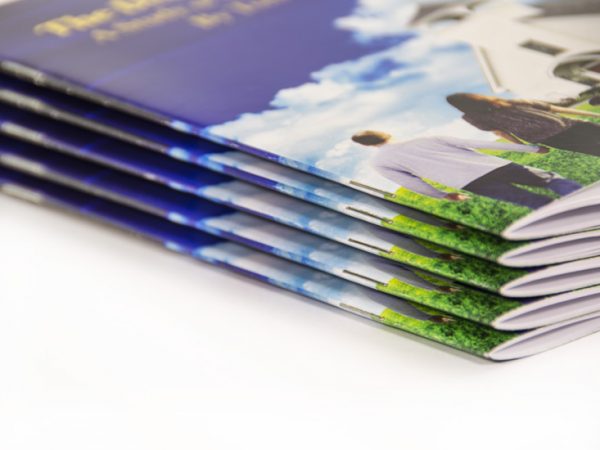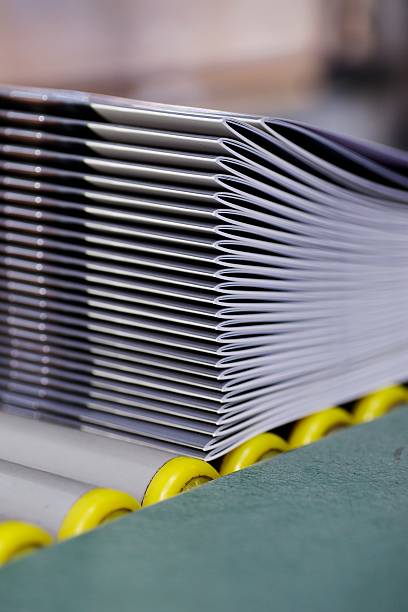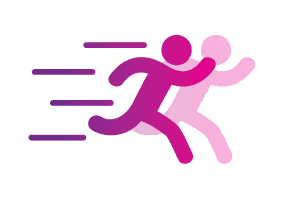
Looking for a wallet-friendly print solution? Saddle stitching booklet binding is your go-to. It’s cost-effective and ensures high-quality results while staying within your budget.
Our booklet printing services encompass a wide range of options, including saddle stitching, to meet all your publishing needs.
Saddle stitching is great for items like brochures and catalogues. It’s not only cost-effective but also delivers fast. MVP Print in Australia is known for top-notch saddle stitching booklets. They offer quality and value without breaking the bank.
Choose saddle stitching and cut down on costs for your projects. Don’t delay, see the savings saddle stitching can bring to you today.
Understanding the Saddle Stitching Process
Saddle stitching is a printing process that folds paper and staples it. It’s called that because it’s like having the paper on a saddle and putting a staple through the middle. This way, your booklet looks professional, opens flat, and is good for documents with several pages.
What is Saddle Stitching Booklet Binding?

This method, known as saddle stitched booklet binding, is a straightforward and budget-friendly option for creating booklets, brochures, and catalogues. The process involves collating pages, folding them in half, and then stapling at the fold. This technique is suitable for printing booklets ranging from 8 to 76 pages. The result is a booklet that stays open and is easy to handle, making it great for reading comfortably or showcasing products and services.
Key Steps in the Saddle Stitching Procedure
Binding a saddle stitched book follows some important steps. These steps ensure the booklet is put together well:
- Collation: The pages are printed and put in the right order.
- Folding: Each page is folded in half.
- Stapling: Staples are placed in the fold to hold the booklet together.
- Trimming: Any extra paper around the edges is cut off.
Every booklet goes through these steps to look the same and be of high quality.
Material Efficiency and the Binding Process
Saddle stitching is smart with materials. It only needs staples and folding, which keeps costs low. This makes it a good choice for both big and small printing jobs. The process is easy to set up, especially for small runs, which also saves you money. It’s a budget-friendly way to make things like event programs, product guides, manuals, and brochures.
The Cost-Effectiveness of Saddle Stitching for Small Booklets
Saddle stitching is a popular choice for small booklets. It is loved by small businesses and marketing campaigns alike. This method doesn’t need much time to set up for shorter print runs. Thus, it keeps the cost low without skimping on quality. Saddle stitching is known for being both versatile and efficient, offering businesses affordable options without sacrificing professionalism.
Turning to saddle stitching works well for creating small booklets without spending too much. This budget-friendly method lets businesses produce materials that look professional and catch the eye. From event programs to product catalogs, it’s a great choice for any small printing project.
Saddle stitching means you can get quality results that look good while keeping costs down. It’s simple, fast, and fits many project sizes. This makes it an excellent choice for a professional yet affordable finish every time.
Benefits of Saddle Stitching for small Booklets cost-effective solution for small businesses, minimal setup time for shorter print runs, professional quality within budget versatile and efficient option for various applications
Moreover, we offer an extensive range of saddle stitched booklets, catering to various business needs and preferences, including different sizes, orientations, and cover options to ensure versatility and customization for our clients.
Advantages of Saddle Stitching for Large Volume Printing

Saddle stitching is great for printing lots of materials quickly and efficiently. It uses wire staples to bind pages. This makes it ideal for things like catalogues and big publications.
Scaling Up: High-Speed Saddle Stitching
Big print jobs need to be done fast and without breaking the bank. Saddle stitching at high speeds does just that. The setup might cost more at first. But, the more you print, the more money you save because it’s so efficient.
Wire Staples: Economical for Extensive Runs
For thick booklets, saddle stitching with wire staples is top-notch. It makes sure everything stays together. Using wire staples means your printing costs can stay low, even when you’re printing a lot.
Advantages Description Cost-effectiveness Saddle stitching is a budget-friendly way to print a large number of materials. It saves money for businesses with big print needs. Efficiency This method is super quick, thanks to high-speed capabilities. It allows for a rapid turnaround and on-time delivery of printed materials. Durability Wire staples provide a solid bind, even for thick booklets. This ensures your materials last a long time. Versatility Saddle stitching works on many types of materials, from catalogues to event programs. It gives lots of flexibility for what you can print.
Saddle Stitching Versus Other Binding Techniques
Saddle stitching is a great choice over other methods because it’s affordable. It lets booklets lay flat, making content easy to read. This method is perfect for all sorts of projects like event programs, catalogs, manuals, and brochures.
Choosing between saddle stitching, perfect, and coil binding depends on what a business needs. Perfect binding looks sleek and is great for thick books. Coil binding lets pages lie flat and is durable. However, when considering the number of pages and printed pages, saddle stitching stands out for projects with a lower page count. The suitability of saddle stitching is influenced by the number of printed pages, as this method requires the page count to be in multiples of four. This limitation is due to the binding process and affects the booklet’s thickness and the potential for ‘creep’—where pages extend slightly beyond the edge. For booklets with a higher page count, alternative binding methods might be more appropriate due to these considerations.
Still, saddle stitching is popular for being budget-friendly, quick to do, and gives a professional look. The best choice for binding depends on the project’s specific needs. Consider things like budget, the number of pages, printed pages, and the design needed. By knowing what each method offers, businesses can pick the right one for their printing needs.
Quick Turnaround Time: How Saddle Stitching Accelerates Delivery
Saddle stitching is great for quick projects. It gets things done fast, fitting tight deadlines just right. At MVP Print, we work hard to make sure your booklets are ready in just one day. This is perfect for items like marketing stuff, program guides for events, or anything else that needs to be out there quickly.
Same-Day Printing Possibility with Saddle Stitching

Want it done today? Saddle stitching says, “No problem.” At MVP Print, we can print your materials and have them ready the very same day. Our process is designed to be fast and efficient, with everything assembled and distributed as soon as the ink dries. This means you can jump on opportunities and push your business forward without waiting.
Streamlined Production: Immediate Assembly and Distribution
Saddle stitching makes the whole process quick. Folding, stapling, and a few trims happen in a flash. This approach at MVP Print shaves off unnecessary time, getting your booklets to you with lightning speed. It’s our way of ensuring your content reaches your audience as swiftly as possible.
Advantages of quick turnaround time, Saddle stitching enables fast production, with booklets often available within one day Same-Day Printing Saddle stitching and offers the possibility of same-day printing, allowing businesses to meet urgent deadlines. MVP Print’s streamlined production process enables timely distribution of saddle-stitched booklets
Page Count Considerations for Saddle Stitching Booklet
Choosing saddle stitching for your book’s binding? Think about how many pages it has. The best page count for saddle stitching is from 8 to 76. Within this limit, the booklet will lay flat and look easy to read and handle.
If your booklet has more than 76 pages, it might not lay as flat. This can make it harder for people to read and use. For more pages, try other binding methods like perfect or coil binding. These methods support thicker booklets better, making them look more professional.
It’s vital to consider how many pages your booklet has for saddle stitching to work well. Submitting files for saddle stitch books as individual pages is crucial to ensure optimal arrangement and adjustments during the printing process. Choosing the right binding for the page count leads to a nicely made, good-looking, and easy-to-use booklet.
Saddle Stitched Books Design Flexibility

Saddle stitched books are flexible in design, offering a range of customization options including the choice to have the inside cover printed for added personalization. This makes it easy to craft eye-catching publications that stand out with their choice of paper, cover printed details, and finishing styles.
Selecting the Right Paper Stock and Finishing Options
Choosing the best paper stock is critical for your book’s look and touch. Think about the paper’s weight, texture, and hue. Your paper might be shiny or matt, smooth or rough, based on your style.
The finish of your book is just as important. A gloss or matte finish can protect it and up its allure. Adding features like embossing adds texture, while spot varnish boosts the visual appeal.
Add Blank Pages to Achieve the Standard Sizes
Standard sizes in saddle stitched books often mean including blank pages. This choice helps in aligning and folding pages correctly. It’s essential for making sure your book stitches together well.
By adding blanks wisely throughout, you can keep your book’s format intact. This lets you maintain beauty and quality. Such a layout ensures your book is both pleasing and professional.
Professional Finish with Varieties of Saddle Stitched Booklet Covers
Saddle stitch binding is a popular method for creating professional-looking booklets, offering a range of cover options to suit various business needs. When deciding on the type of cover for a saddle stitch booklet, businesses can choose between a self cover, which uses the same paper as the interior pages, and a hard cover, which provides a more durable and premium feel. This variety in saddle stitch booklet covers allows for customization that can enhance a brand’s presentation, making saddle stitch booklets adaptable to various branding requirements.
Choosing Between Self Cover and Hard Cover Options
A self cover matches the inside pages, giving it a seamless appearance. This choice suits booklets with a similar design all through. It looks smooth and makes the booklet seem more professional.
Alternatively, a hard cover makes a booklet more durable. It’s tougher because it’s made from thicker materials. This is good for booklets people will handle a lot or those in rough conditions.
Customisation to Enhance Brand Presentation
Aside from the cover, you can customise saddle stitched booklets to boost your brand. Pick different feels, coatings, or sizes to make your booklet unique. This helps it fit with your brand’s style and design perfectly.
Textures like matte or gloss can make the booklet more interesting. Coatings such as UV or laminate make it last longer and look sleek. Also, you can choose embossing or foil stamping for a special touch that catches the eye.
By customising, your booklets will leave a strong impression. This makes your brand look more professional and memorable to your audience.
Environmentally Friendly Benefits of Saddle Stitching

Saddle stitching is great for the planet, offering many eco-friendly perks. It’s a smart choice for businesses wanting to print and bind responsibly. The process is simple and cuts down on waste by using materials that can be recycled.
By using saddle stitching, companies help decrease the damage to our environment done by old-school printing and binding ways. It uses very little energy, which is also a plus for the planet. This makes it a choice that really cares about our Earth.
Businesses looking to be more green can choose saddle stitching. It’s a step towards printing in a way that doesn’t harm the environment. By going eco-friendly with their print work, companies lessen their impact on the planet. This move helps make tomorrow a more eco-friendly place.
Conclusion
Saddle stitching is a cost-effective choice for businesses’ printing needs. It keeps quality high while saving money. This makes it great for binding booklets.
This method is fast, helping companies meet deadlines. MVP Print in Australia offers top-notch services. They make sure clients get the best value.
Saddle stitching suits many purposes, like event programs or brochures. It lets businesses make their materials their way. It’s not only budget-friendly but also eco-friendly, supporting green printing.








